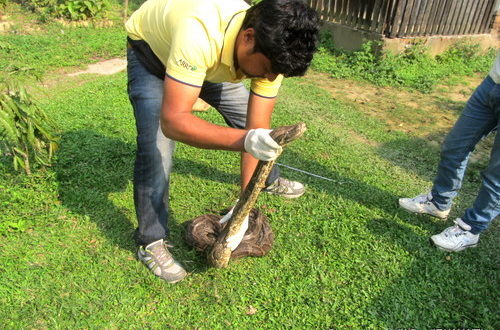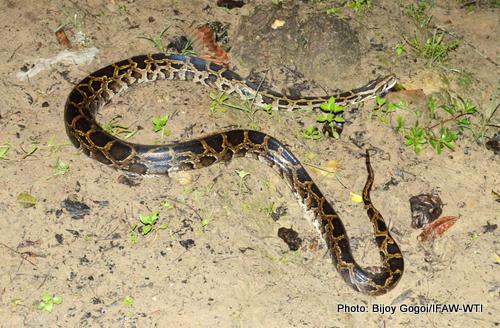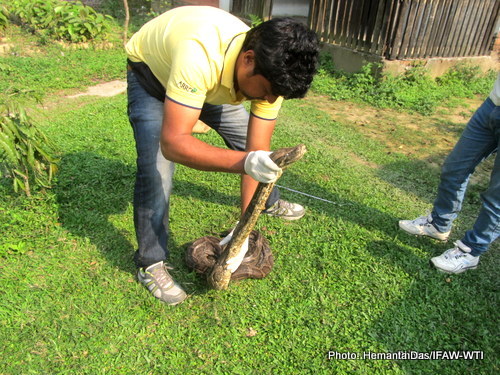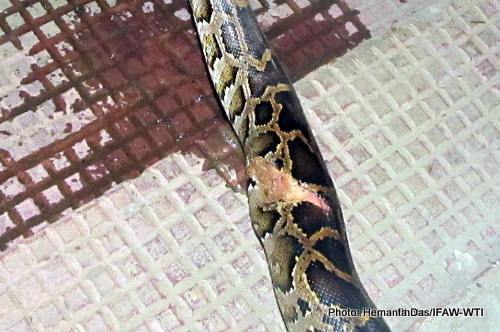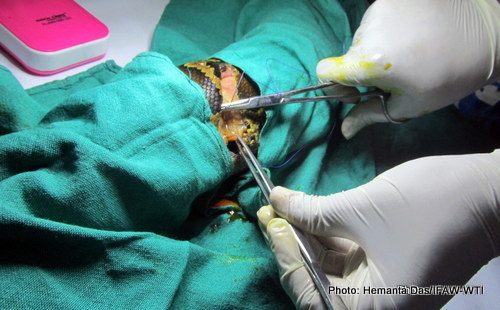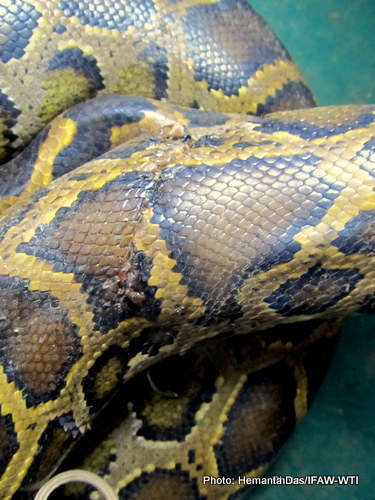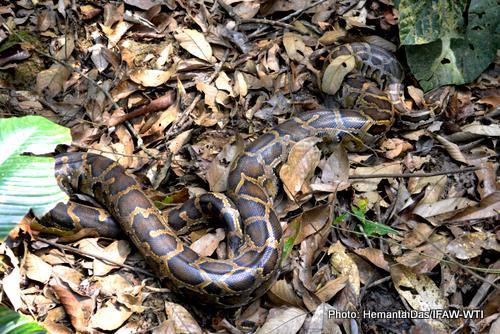She is still on my Mind!
She’s still on my mind. The gorgeous brown blotches bordered in black down the back and her long, slithery body takes me back to the days of her small week-long stay at the IFAW –WTI run Center for Wildlife Rehabilitation and Conservation (CWRC) satellite station. She was a beautiful Burmese python that was 7.5 feet long and weighed 7.4 kg.
Listed as a Schedule 1 species under the Wildlife (Protection) Act, 1972, the Burmese python is the largest sub-species of the Indian python and one of the six largest snakes in the world. The sheer beauty of this slithering reptilian has captivated my imagination since my stint at the CWRC satellite station.
On March 12, 2015, I was discussing conflict mitigation with some local conservationists when my phone began to ring. It was Mr. Rajiv Rudra Tariang, Asst. Professor, Department of Zoology, Digboi College. A well know environmentalist and a good friend of mine informed me about a Burmese python in need of rescue and treatment on the fringes of Saraipung Wildlife Sanctuary in Tinsukia, Assam.
On hearing the news, I directed our MVS unit to rush to the spot. Tinsukia was 50 km away from the spot we were at and I asked Hemanta Das, the animal keeper and driver, to speed to ensure that we reach at the earliest. On reaching the exact location after an hour, it was such a pleasure to see this gigantic beauty. But soon my joy turned into gloom when I noticed severe injuries on this beautiful animal.
I enquired with the local rescuers and AFD who informed that the python sustained injuries when massive excavator machines were digging earth to clear the land for an infrastructure project near the Saraipung WLS. And, the snake found itself amidst mammoth iron shovels and got injured during the excavation. At first, we couldn’t assess the extent of the injury and took the reptilian to Eastern Assam CWRC satellite station in Dhola, Tinsukia.
Unfortunately, there was no electricity so I decided to go ahead using a chargeable electric lamp. The snake was administered anaesthesia and operation was conducted with the help of an animal keeper. The surgery lasted till 12:00 and then the snake was left in an incubated cage. It took the Burmese python six hours to recover from anaesthesia.
The first day of treatment didn’t turn out as I had hoped for as she was tremendously aggressive whenever I tried changing her dressing. However, second day onwards she remained calm when I was dressing her. I guess she too knew that we were trying to save her. She was dressed till her external sutures were removed. Finally, after a week of care, she was ready to be released into the wild.
We then released her at Saraipung under Dehing Patkai WLS, closer to the place where we found her. When she was released, I was overwhelmed at the sight of this magnificent creature wriggling its way back into the dense forest and the fact that we had been successful in releasing it back to its home. Since its inception, the CWRC Satellite Station MVS EA has handled 22 Burmese python cases.
Reptiles usually adapt themselves in any kind of habitat and are opportunistic enough to take chances to go near human habitation for food. I believe that this is one of the primary reasons why we see so many of these reptilians around human settlements. It was the first Burmese python rescue conducted by EA-MVS in 2015.
Fortunately or unfortunately, I have come face to face with a Burmese python not once, not twice, but thrice in the last couple of months this year. Coincidentally, I have spotted the snake on all three occasions in Tinsukia district of Assam, where I am posted as a veterinarian with the IFAW-WTI run Mobile Veterinary Service (MVS).
During the second rescue, the Burmese python came under some heavy object and since the snake was old and weak, it couldn’t escape. Unable to raise its head, the snake had not even molted well and its skin contour was very bad. This particular snake died during the course of the treatment. The third rescue case was of snake that had injuries on its head. According to the locals, a boy started pulling a pythons’ tail and the snake bit his hand. So the boy made fatal injury on the snake’s head, but we were able to save her after surgical interventions and much to my joy, she was released back to wild.
These snakes are such beautiful creature, so docile that it can be handled very easily. And, my heart bleeds when this magnificent specie becomes a victim of human wrath. Reptiles have an important role in ecology, but the fear and lack of awareness takes a toll on this beautiful animal whenever there is some sort of interaction with humans. Vilified for centuries, snakes, even the non-venomous kinds, draw human ire and most often do not survive the brutal onslaught.
The need of the hour is to understand their importance before it’s too late.

